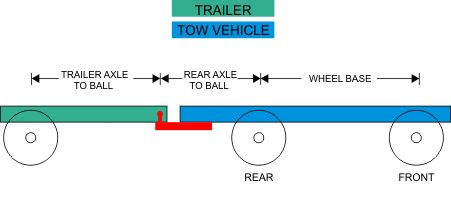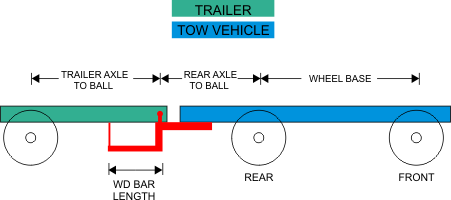Trailer Towing Calculator
Weight Carrying vs Weight Distribution Hitches
Description:
Trailer towing calculator to compare weight carrying versus weight distribution hitch configurations.
In a weight carrying (WC) configuration the entire weight of the travel trailer tongue weight is applied to the tow vehicle.
A weight distribution (WD) hitch uses torque or rotational force to transfer the load. The load is transferred to the tow vehicle's front axle and the trailer's axle. How a weight distribution hitch works will be reviewed below the calculator.
Important:
Do not solely rely on this calculator to determine weights and loads. This calculator is intended to give a rough estimate of loads and weights. A tow vehicle and trailer combination should alway be inspected at a certified truck scale or weigh station. All manufacturer setup instructions, installation guidelines and safety warnings should be followed regardless of the following calculations.
Enter Tow Vehicle Ratings/Dimensions
GVWR:
lb
GCWR:
lb
FGAWR:
lb
RGAWR:
lb
Max Loaded Trailer Weight:
lb
Wheelbase:
in
Rear Axle to Ball Length:
in
Enter Tow Vehicle Weights
GVW:
lb
Front/Rear Distribution:
%
FGAW:
0
lb
RGAW:
0
lb
Enter Hitch and Ball Ratings
WC Max Trailer Weight:
lb
WC Max Tongue Weight:
lb
WD Max Trailer Weight:
lb
WD Max Tongue Weight:
lb
Ball GTW Rating:
lb
Enter WD Hitch Specs
Tension (Total):
lb
Bar Length:
in
Enter Trailer Ratings/Dimensions
GVWR:
lb
GAWR:
lb
Axle to Ball Length:
in
Enter Trailer Weights
GVW or GTW:
lb
Tongue-Axle Weight %:
%
Tongue Weight:
0
lb
GAW:
0
lb
Solution and Charts
Tow Vehicle GVWR
Load
Rating
Weight Carrying:
Weight Distribution:
Tow Vehicle GCWR
Load
Rating
Weight Carrying:
Weight Distribution:
Tow Vehicle FGAWR
Load
Rating
Weight Carrying:
Weight Distribution:
Tow Vehicle RGAWR
Load
Rating
Weight Carrying:
Weight Distribution:
Tow Vehicle Max Loaded Trailer Wt
Load
Rating
Weight Carrying:
Weight Distribution:
Hitch Max Tongue Weight
Load
Rating
Weight Carrying:
Weight Distribution:
Hitch Max Trailer Weight
Load
Rating
Weight Carrying:
Weight Distribution:
Ball GTW Rating
Load
Rating
Weight Carrying:
Weight Distribution:
Trailer GVWR
Load
Rating
Weight Carrying:
Weight Distribution:
Trailer GAWR
Load
Rating
Weight Carrying:
Weight Distribution:
Are you able to help others? Share this page.
Instructions:
- Enter tow vehicle ratings and weights.
- Enter trailer vehicle ratings and weights.
- Enter hitch ratings and weights.
Note, the solutions will automatically be updated when any of the input date fields are modified or changed.
The solution section contains the calculated load and rating for each of the enter truck or trailer ratings. For some loads, the value is simply the entered weight.
In addition, gauge charts are provided to visualize the loads. If the needle is in the green the load is within the rating. Red represents an exceeded load. The transition between the green and red areas represents the rating.
Forces:
In the study of statics and dynamics there are two types of forces, linear and rotational. Statics is the study objects in equilibrium or at rest. This means the object is not moving. If a force causes an object to move then it becomes dynamic. Tow vehicle and trailer ratings are based on statics, since nothing is moving when weighed. This calculator is based on static evaluation.
In statics, the summation of linear forces must equal zero. Likewise, the summation of rotational forces muse equal to zero. If either of these forces is not zero, then it is a dynamic situation.
Weight Carrying Hitch:
 The weight carrying hitch configuration transfers the entire tongue weight of the trailer to the tow vehicle. This increases the load to the rear axle and reduces the load on the front axles. This is due to the additional vertical linear force from the trailer tongue weight. In addition, rotational forces centered at the rear axle causes a portion of tow vehicle's weight to be transferred to the rear axle. Typically in this configuration the rear axle rating is the first rating to be exceeded. This is due to the additional trailer weight and vehicle weight transfer to the rear axle.
The weight carrying hitch configuration transfers the entire tongue weight of the trailer to the tow vehicle. This increases the load to the rear axle and reduces the load on the front axles. This is due to the additional vertical linear force from the trailer tongue weight. In addition, rotational forces centered at the rear axle causes a portion of tow vehicle's weight to be transferred to the rear axle. Typically in this configuration the rear axle rating is the first rating to be exceeded. This is due to the additional trailer weight and vehicle weight transfer to the rear axle.If the trailer is too heavy it may cause vehicle handling problems. The vehicle may to be able to steer properly since there is not enough weight on the front tires. In addition, trailer sway issues may arise. In extreme cases, the front tires can lift off the ground. If the tires lift off the ground, the entire weight of the vehicle is supported by the rear axle. The weight has to supported.
Weight Distribution Hitch:
 The weight distribution hitch configuration transfers the load from the vehicle's rear axle to the vehicle's front axle and the trailer's axle. This reduces to load on the rear axle allowing the tow vehicle to pull a larger trailer.
The weight distribution hitch configuration transfers the load from the vehicle's rear axle to the vehicle's front axle and the trailer's axle. This reduces to load on the rear axle allowing the tow vehicle to pull a larger trailer.The weight transfer is caused by rotational forces centered at the hitch ball. Typically a tensioned chain produces the rotational forces or torque. For the tow vehicle, the chain pulls up on the weight distribution bar. This results in a reduced load on the vehicle rear axle and an increase on the front. For the trailer, the chain pulls down
on the tongue which increase the load on the trailer's axle. Remember the ball in the center of the rotation, the moment, for a weight distribution hitch.
Interestingly, the weight distribution hitch's vertical linear forces cancel each other out. Therefore, the weight distribution hitch only produces rotational forces center at the ball. Importantly, it does not reduce the tongue weight applied to the vehicle's frame. The full tongue weight rests on the vehicle's frame. This is important when calculating Gross Vehicle Weight (GVW). Even though the rotational forces are transferring the weight, the tow vehicles frame is still supports the entire vertical linear force of the trailer's tongue weight. The torque only reduces the loads at the axles not the frame.
Inputs: Tow Vehicle Ratings/Dimensions
The following specifications are usually found on the door jamb label or owner's manual.
GVWR - Gross Vehicle Weight Rating:
The maximum weight capacity the vehicle can support.GCWR - Gross Combined Weight Rating:
The maximum combined weight of the vehicle and trailer. When weighed the vehicle and trailer should be fully loaded.FGAWR - Front Gross Axle Weight Rating:
The maximum weight carrying capacity of the front axle.RGAWR - Rear Gross Axle Weight Rating:
The maximum weight carrying capacity of the rear axle.Max Loaded Trailer Weight:
The maximum weight of the trailer the vehicle can pull or tow.Wheelbase:
The distance between the front and rear axles.Rear Axle To Ball Length:
The distance between the rear axles and the hitch ball.Inputs: Tow Vehicle Weights
The following are measured at a weigh station. The trailer should not be attached to the vehicle.
GVW - Gross Vehicle Weight:
The gross vehicle weight includes the vehicle weight itself, trailer tongue weight, passengers, fuel and any additional cargo. Cargo could include camping equipment, generators, chairs, firewood or anything carried in the bed or cab of the truck.Front/Rear Distribution:
The percentage of the vehicles weight which is supported by the front axle. This is used to calculate FGAW and RGAW. Use this the adjust the FGAW and RGAW to the value measured from the weigh station.FGAW - Front Gross Axle Weight:
The actual load the front axle is supporting. This is a calculated value.RGAW - Rear Gross Axle Weight:
The actual load the rear axle is supporting. This is a calculated value.Inputs: Hitch and Ball Ratings
The following specifications are usually found on the hitch receiver label and stamped on the ball.
Weight Carrying Maximum Trailer Weight:
The maximum trailer weight the hitch can tow without a weight distribution hitch.Weight Carrying Maximum Tongue Weight:
The maximum tongue weight the hitch can support without a weight distribution hitch.WD Max Trailer Weight:
The maximum trailer weight the hitch can pull with a weight distribution hitch.WD Max Tongue Weight:
The maximum tongue weight the hitch can support with a weight distribution hitch.Ball GTW Rating:
The maximum gross trailer weight the ball can tow.Inputs: Weight Distribution Hitch Specifications
Tension:
The total tension the chains place on the bars. If tow bars produce 1,0000 pounds of tension each, then enter two thousand.Bar Length:
The length of the bar.Inputs: Trailer Ratings Dimensions
The following specifications are usually found on the trailer rating sticker.
GVWR - Gross Vehicle Weight Rating:
The maximum trailer weight capacity of the trailer.GAWR - Gross Axle Weight Rating:
The maximum weight carrying capacity of the axles.Axle to Ball Length:
The length between the trailer axle and hitch ball.Inputs: Trailer Weights
The are determined at the weigh station. These values are for an unattached trailer.
GVW - Gross Vehicle Weight:
The actual trailer and loaded cargo weight. Cargo includes anything loaded into the trailer. It includes water, propane thanks, etc. This is sometimes state as Gross Trailer Weight (GTW)Tongue-Axle Weight Percentage:
The percentage of the trailer's weight which is supported by the tongue.Tongue Weight:
The weight of the tongue. This is a calculated value.GAW:
The actual load on the trailer's axle. This is a calculated value.
Infant Growth Charts - Baby Percentiles
Overtime Pay Rate Calculator
Salary Hourly Pay Converter - Jobs
Percent Off - Sale Discount Calculator
Pay Raise Increase Calculator
Linear Interpolation Calculator
Dog Age Calculator
Newton Second Law of Motion
Towing: Weight Distribution Hitch
Heart Rate Maximum Calculator
Weight Equations Formulas Calculator
Tire Size Comparison Calculator
Horsepower Car Equations Calculator
Lightning Distance Calculator
Rule of 72 Interest Calculator
Ohm Law Calculator
Site Links:
Home: PopularIndex 1Index 2Index 3Index 4Infant ChartMath GeometryPhysics ForceFluid MechanicsFinanceLoan CalculatorNursing Math
Web Apps, Rich Internet Application, Technical Tools, Specifications, How to Guides, Training, Applications, Examples, Tutorials, Reviews, Answers, Test Review Resources, Analysis, Homework Solutions, Help, Data and Information for Engineers, Technicians, Teachers, Tutors, Researchers, K-12 Education, College and High School Students, Science Fair Projects and Scientists
By Jimmy Raymond
Contact: aj@ajdesigner.com
Copyright 2002-2015